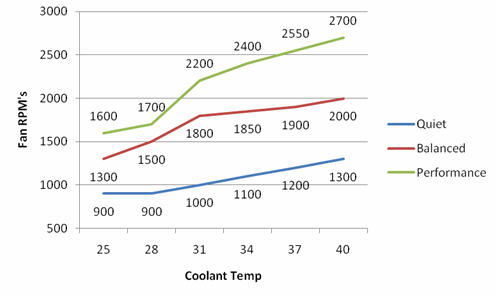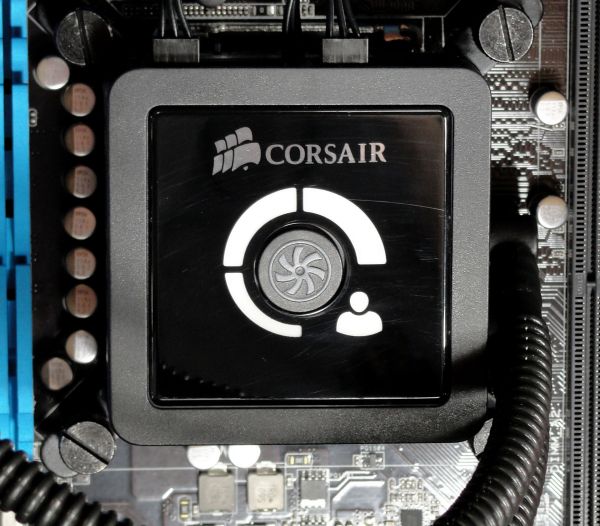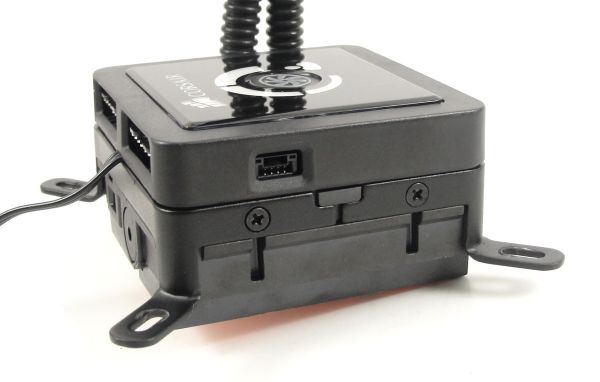Corsair Hydro Series: H60, H80 and H100 Reviewed
by Jared Bell on November 7, 2011 12:00 AM EST- Posted in
- Cases/Cooling/PSUs
- Corsair
- Water Cooling
H60, H80, and H100 Overview
As always with Corsair products, packaging and box art are top notch. We’ll start with the lowest tier offering, the H60, and then move to the H80 and H100.
H60 High Performance Details
The H60's radiator is the same size of the previous generation H50. However, the H60 has a new, upgraded water block that allows for more efficient flow. It also has the adjustable 90 degree connectors we've seen on the H70 making installation easier. Corsair provides a single 120mm 1700RPM PWM fan. The inclusion of a PWM fan is a nice touch since most motherboards have the needed 4-pin connector and have BIOS settings for easy fan speed control. This means the cooler can be virtually silent when idle, but ramp up the RPMs (and therefore noise) as needed. As mentioned, the H60 only includes one fan, but you can add a second fan for a push/pull configuration. You'll just need to pick up an extra set of 6x32x1-1/4" screws.
H80 High Performance
The H80 takes over for the H70 with its thicker radiator design but shares the same new, upgraded water block as the H60. However, the H80 and the H100 have an all new push-button fan control that lets you select the fan speed and cooling performance setup that best suits your needs. The white LED display lets you know which profile is being used. The H80 can power and control up to two fans. Thankfully, like the H70 before it, the H80 already comes with two fans for a push/pull configuration. The included fans are 3-pin and spin at 2500RPM when the fan controller is set to its highest setting. We’ll provide more information on the fan speed profiles later.
H100 Extreme Performance
The H100 is an all new double-wide design sporting a 240mm [or 2x120mm] radiator that has the same thickness as the H60. The water block and fan controller are the same that we've seen on the H80; however, the H100's fan controller can power and control up to four fans even though the unit only comes with two. This gives you the option of adding two more fans for push/pull on this bad boy. The two included fans are the same high speed 2500RPM fans that come with the H80.
Fan Controller
The three speed push-button fan controller on the H80 and H100 is a great improvement over what Corsair offered previously with the H70. The H70 included two inline resistors for providing a second, lower fan speed. The new built-in fan control system on the H80 and H100 gives you three settings to choose from: low, medium, or high—or as Corsair calls it: low noise, balanced, and high performance. While some may complain you have to open your case to make changes, I think of it as more of a set it and forget it type thing. Corsair doesn't stop there though; each speed setting or profile actually has an RPM range for the fans to spin at. This means the fans will be quieter when idle and only reach their max rated RPM (and max noise) for that particular profile when the coolant inside reaches a certain temperature. Could this lead to the perfect balance of performance and noise? We'll hopefully find out with our tests in just a moment.

Corsair Link
The H80 and H100 both support Corsair's Link Digital, which is their suite of hardware and software for monitoring various system parameters. It also allows you to customize your own performance profiles. We don't have one of the Corsair Link's on hand, so we will not be testing this feature. It's unfortunate that Corsair doesn't include the Link with the H80 or H100, but I'm guessing they opted to make it optional so the price wouldn't go through the roof.



























91 Comments
View All Comments
Mjello - Monday, November 7, 2011 - link
If you don't mind temps howering in the 70C-75C range the h100 can do it passive mounted externally in a horisontal position in a 25C room.Just did an hour of LoL. It wont do prime95 for more than 10 min. however. So heavy loads is a nogo passive. And a silent fan doesn't make any noice so i'll switch mine back on. Was a fun experiment though.
double0seven - Tuesday, November 8, 2011 - link
"We could hook up our video cards and CPU to the loop."This part doesn't make logical sense. If you "hooked up" multiple heat generators to a coolant loop, only the first one would get cooled.
ggathagan - Monday, November 7, 2011 - link
Page 3, last sentence of the 1st paragraph: I didn't have any filament problems....I'm guessing fitment is the word you intended.
Hey, someone has to pick at this stuff...
fixxxer0 - Tuesday, November 8, 2011 - link
what was the ambient temp of the room on average? just curious to see what your actual temps were...compudaze - Tuesday, November 8, 2011 - link
Ambient temps were 22.2C - 24.8C with an average of 23.8C.medi01 - Tuesday, November 8, 2011 - link
It's been a while, that most power hungry part of the system is a graphic card.What a pity they don't make water cooling solution for them.
I don't quite get why on earth I would install this thing, if I still have to care what to do with graphic card heat.
kg4icg - Tuesday, November 8, 2011 - link
Cool IT does make a sealed solution for video cards.http://www.coolitsystems.com/index.php/products/gp...
Sabresiberian - Tuesday, November 8, 2011 - link
It's good to see these coolers get to the point where they are really good, even if the cost is a bit high still. I think pretty soon, liquid coolers will be the thing to use in all but inexpensive systems.I'm not sure the H100's price is too high; it depends on what a serious overclocker wants, and whether it allows more room than something like the Silver Arrow. Adding another 2 fans will make even more difference (and add to the cost), which will give more of a performance edge to it. Theoretically, anyway, air flow through the radiator may not be the limiting factor in the system.
I use the CoolIT Eco on one of my rigs (similar to the H60). It's a decent cooler, but the main reason I used it was because I needed a lower profile solution with my Antec Skeleton "case", and these type coolers really work great for that. Of course, you are just moving the space issue to a different location, since there's the radiator to deal with, but that's not an issue with the Skeleton since I just made a bracket to hang it off a side.
;)
Googer - Wednesday, November 9, 2011 - link
Shame corsair didn't show off the "Corsair Link" kit and demonstrate its abilities. I guess they don't want to sell too many of those $100-129 (USD) kits. Sounds like the Bob's Rug Syndrome (GTE)http://www.ricklatona.com/2008/06/01/the-bobs-rug-...
Drekkyk - Wednesday, November 9, 2011 - link
I tried the H60, but at 4.5 Ghz the temp was 8 degrees C hotter than my Cooler Master Hyper 212+. under load and at idle. What I really noticed was how much slower the temp reduced when going from full load to none. I really wanted to like it, I even tried remounting, ensuring thermal compound was applied correctly, etc. I used the same compound for both coolers. My case is a Haf-X with plenty of airflow.